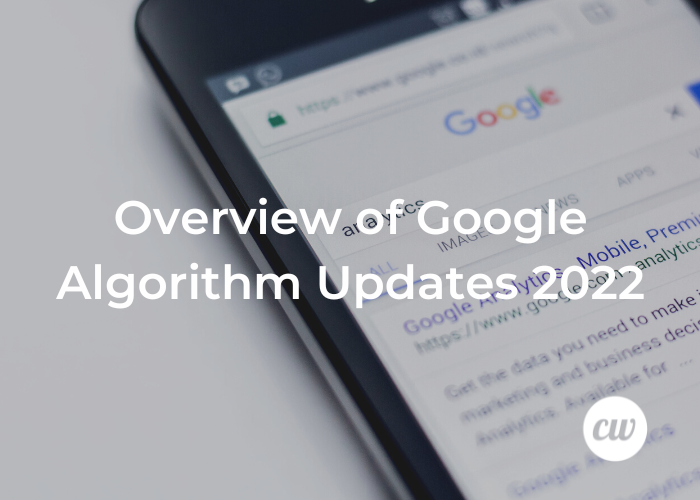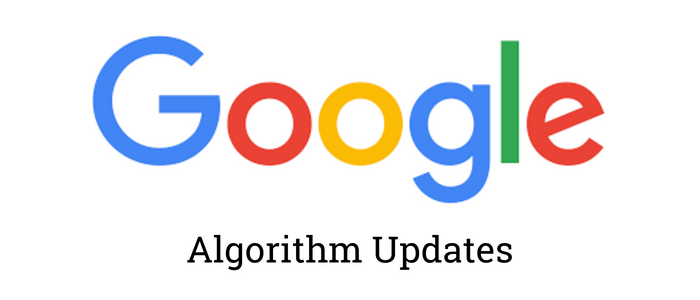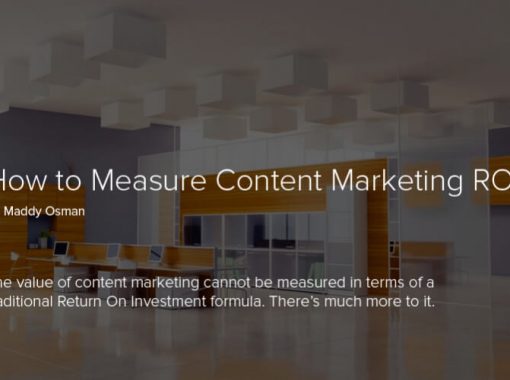
Overview of Google Algorithm Updates 2022
Making sure your content ranks highly on search engines is crucial to discovery. Less than 6% of search engine users click on results from the second page.
However, creating search engine-friendly organic content that provides value to users can be challenging. It’s also a moving target. Google makes several hundred tweaks to its algorithm every year — some big and some small.
It can be dizzying to try to stay on top of all of them, so we’ve put together this guide of the most notable Google algorithm updates for 2022 and how they can affect your business, website, and content marketing strategy.

What Is the Latest Google Algorithm Update?
The latest Google algorithm update in 2022 is the spam update launched in October. It features an update to SpamBrain, the engine used to identify spam. Google did not detail what changes were made, saying simply that if you follow Google Search Essentials, you are likely to be fine.
Google Core Algorithm Update 2022
The big updates the search engine company rolls out are called core updates. These include broad changes to the algorithms and can cause fluctuations in search results.
Core updates are often complex and tackle multiple issues. Google isn’t exactly forthcoming on what is included in core updates, either. They don’t generally release details about core updates, instead pointing to the best practices for search ranking that haven’t changed since the August 2019 core update.
These best practices are fairly general, including tips like offering quality content. Google also says it favors:
- Original information, reporting, research, or analysis
- Insightful analysis or information that goes beyond the obvious
- Clear sourcing and evidence of expertise
- Substantial value compared to other web pages
There were two core updates in 2022.
Google Algorithm Update September 2022
The most recent core update in 2022 was in September, and solidified elements of the Google algorithm update in August 2022, called the helpful content update.
Google defined helpful content as people-first rather than content developed to manipulate search engine rankings. In other words, practices like keyword stuffing, rewriting content available elsewhere, or summarizing content without providing additional value will not help you rank.
While Google’s systems use a wide variety of factors to determine rankings, it also emphasizes what it calls E-A-T and YMYL. E-A-T stands for expertise, authoritativeness, and trustworthiness. YMYL is an acronym for “Your Money or Your Life,” which Google defines as topics that impact health, safety, well-being, or financial stability.
Google Algorithm Update May 2022
The May 2022 core update appeared to have a significant impact on search engine results pages (SERPs), creating a significant level of volatility and changes in rankings.
As with previous core updates, Google didn’t release specific information about what’s changed and warned site owners that changes are designed to improve how its systems assess content and that there may be nothing for site owners to change or fix.
Other Notables Algorithm Updates in 2022
Here are some of the other notable Google algorithm updates from throughout the year.
September 2022: Product Reviews
In the fourth update to product reviews in the past two years, Google continued its focus on rewarding high-quality product reviews that provide insight, analysis, or original research written by experts. More weight is given to product reviews that provide in-depth content rather than “thin content” that summarizes products.
August 2022: Helpful Content
As mentioned above, the August 2022 Google algorithm update emphasized people-first content, providing greater weight to sites that offer satisfying content that meets searcher intent.
March 2022: Product Reviews
This earlier product review update included guidance from Google on what matters when it comes to product reviews, including:
- In-depth details, such as pros and cons, how products perform, and how products compare to earlier versions
- Reviews from people that have used the product, rather than manufacturers
- Unique information beyond what product makers provide, such as images and videos
- Comparison to other products or explanations about what makes a particular product unique
February 2022: Page Experience for Desktop
Google has previously rolled out page experience for mobile. With this update, they also applied many of the same standards to desktop sites. One notable exception is that the mobile-friendly test is not applied to desktop sites if there are separate desktop and mobile sites. In other words, this update only applies to what users see when they access the site on a desktop.
The page experience for desktop update focused on Core Web Vitals for loading, interactivity, and visual stability. Core Web Vitals include:
- Largest Contentful Paint (LCP)
- First Input Delay (FID)
- Cumulative Layout Shift (CLS)
Largest Contentful Paint (LCP)
LCP assesses a site’s performance when it comes to loading times. Google recommends sites have LCP that occurs within the first 2.5 seconds from access. This applies to the largest image or text block on the page when it loads.
First Input Delay (FID)
FID calculates how long it takes before users can interact with a page in relation to how long it takes the browser to process. For example, if users click on a button or link, how long does it take for action to begin?
The goal is to reward sites that can reduce latency. This impacts sites that have large scripts running, which may delay reactions to user input while scripts load in the browser. For example, if a browser is parsing a larger-sized JavaScript file, it will be unable to run “event listeners” to recognize and process input instantly.
Google suggests sites should have a first input delay of fewer than 100 milliseconds.
Cumulative Layout Shift (CLS)
CLS takes into account visual stability. Layout shifts occur when visible elements change positions while loading. When a web page or app loads, Google wants to see a consistent visual performance as the site loads.
Google looks for a CLS score of no more than 0.1.
Other Updates
The page experience update also looked for interstitials, favoring sites that do not have intrusive interstitials that disrupt the user experience.
Google also clarified that secure site connections are a ranking signal for desktops. Pages should be served using HTTPS rather than HTTP. This has become a concern for publishers and site owners ever since Google updated its Chrome browser, flagging sites not using HTTPS as not secure.
Google Search Essentials
It can be extremely challenging to stay on top of all the algorithm changes and updates throughout the year. While Google highlights its core updates, they don’t provide details. While they may elaborate more on specific changes, such as helpful content or Core Web Vitals, other tweaks to the algorithm happen behind-the-scenes with little or no fanfare.
The one piece of advice Google offers consistently for publishers, site owners, and content developers is to focus on Google Search Essentials.
Search Essentials focuses on technical requirements, spam policies, and best practices.

Technical Requirements
Provide the technical information Google needs to index and analyze your site. If your website meets the minimum technical requirements, it’s good to go. These minimum requirements include:
- Making sure Googlebot is not blocked. Googlebot is the web crawler Google uses. If a page is marked as private, the Googlebot can’t see it. For example, gated content that requires a password for access is not crawlable.
- Making sure web pages work properly. Google will only index pages that serve with a 200 (success) status code.
- Pages contain content that can be indexed. Pages need to contain content in a file type that Google supports.
You can check specific pages using Google’s free URL inspection tool.
Spam Policies
Sites must adhere to Google’s spam policies. This includes not engaging in practices such as:
- Site cloaking: Showing different content to search engines and site visitors
- Doorways: Pages that are designed to rank for specific search queries, such as multiple websites with slight variations to URLs or substantially similar to other pages
- Hidden links or text: Placing text or links to manipulate search engines, such as using white text on a white background or using CSS to position text off-screen
- Keyword stuffing: Filling pages with a large number of keywords designed to manipulate search ranking, such as repeating the same words over and over in an unnatural manner
- Link spam: Buying or selling links or using automated services to create links to your site
- Bot use: Using machine-generated traffic to send queries to Google or to scrape results for rank checking
- Scraped content: Sites that copy and republish content from other sites without adding additional value or citing sources, or spinning content to provide slight differences
- Improper redirects: Showing search engines certain content but redirecting users to different content or domains
- Thin affiliate pages: Pages including affiliate links where product descriptions have been copied from original sources
Google spam policies also apply to sites that have been hacked, have misleading functionality, contain malware, or exhibit malicious behavior.
Best Practices
Best practices for publishers, site owners, and content developers all center around delivering quality content that meets searchers’ intent. Google offers these best practices:
- Create trustworthy, reliable, and helpful content.
- Use words that reflect how people search in a prominent location, such as titles and headings.
- Ensure your links are crawlable so Google can find other pages from your site.
- Make sure you follow best practices for structured data, images, videos, and JavaScript so that Google can understand them.
- Pay attention to how your site appears on Google Search.
- Exclude content that you do not want to be searched.
Develop High-Quality, SEO-Enhanced Content
Properly executed search engine optimization (SEO) tactics can help your site rank on Google, but they won’t pay off if you aren’t providing quality content that provides value for visitors. While it’s important to stay on top of Google algorithm updates, the most important thing is to create content that providers value and demonstrates your expertise — providing detail, insight, or information that is different and goes beyond what can be found elsewhere online.
At ContentWriters, we can help you create high-quality content that meets your goals and applies best practices for Google searches. Contact ContentWriters today and let’s get started!
Paul is a multiple Emmy Award® winner with more than 20 years of experience as a journalist working for some of the country’s top publishers. For the past 10 years, Paul has worked as a marketing and advertising expert on projects for hundreds of clients.




